过去分词的句法功能
- 格式:doc
- 大小:24.50 KB
- 文档页数:4
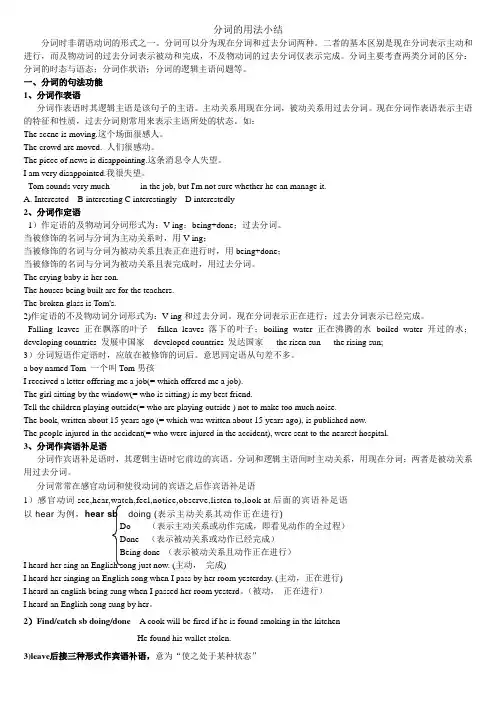
分词的用法小结分词时非谓语动词的形式之一。
分词可以分为现在分词和过去分词两种。
二者的基本区别是现在分词表示主动和进行,而及物动词的过去分词表示被动和完成,不及物动词的过去分词仅表示完成。
分词主要考查两类分词的区分:分词的时态与语态;分词作状语;分词的逻辑主语问题等。
一、分词的句法功能1、分词作表语分词作表语时其逻辑主语是该句子的主语。
主动关系用现在分词,被动关系用过去分词。
现在分词作表语表示主语的特征和性质,过去分词则常用来表示主语所处的状态。
如:The scene is moving.这个场面很感人。
The crowd are moved. 人们很感动。
The piece of news is disappointing.这条消息令人失望。
I am very disappointed.我很失望。
Tom sounds very much_______in the job, but I'm not sure whether he can manage it.A.Interested B interesting C interestingly D interestedly2、分词作定语1)作定语的及物动词分词形式为:V-ing;being+done;过去分词。
当被修饰的名词与分词为主动关系时,用V-ing;当被修饰的名词与分词为被动关系且表正在进行时,用being+done;当被修饰的名词与分词为被动关系且表完成时,用过去分词。
The crying baby is her son.The houses being built are for the teachers.The broken glass is Tom's.2)作定语的不及物动词分词形式为:V-ing和过去分词。
现在分词表示正在进行;过去分词表示已经完成。
Falling leaves 正在飘落的叶子fallen leaves 落下的叶子;boiling water 正在沸腾的水boiled water 开过的水;developing countries 发展中国家developed countries 发达国家the risen sun the rising sun;3)分词短语作定语时,应放在被修饰的词后。


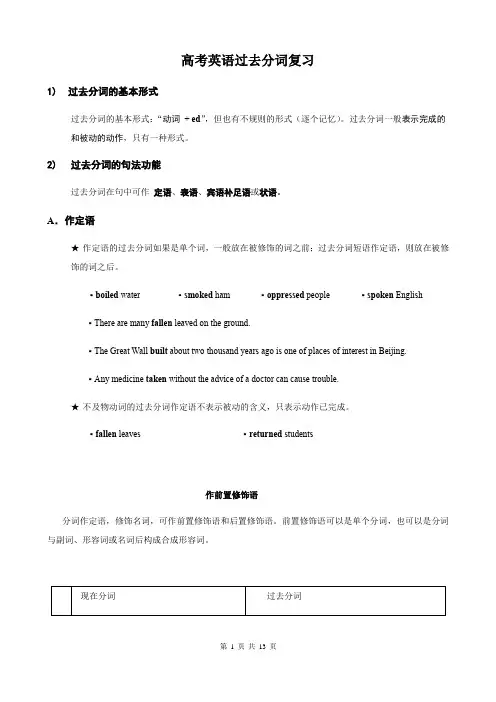
高考英语过去分词复习1) 过去分词的基本形式过去分词的基本形式:“动词+ ed”,但也有不规则的形式(逐个记忆)。
过去分词一般表示完成的和被动的动作,只有一种形式。
2) 过去分词的句法功能过去分词在句中可作定语、表语、宾语补足语或状语。
A.作定语★作定语的过去分词如果是单个词,一般放在被修饰的词之前;过去分词短语作定语,则放在被修饰的词之后。
▪boiled water▪smoked ham▪oppressed people▪spoken English▪There are many fallen leaved on the ground.▪The Great Wall built about two thousand years ago is one of places of interest in Beijing.▪Any medicine taken without the advice of a doctor can cause trouble.★不及物动词的过去分词作定语不表示被动的含义,只表示动作已完成。
▪fallen leaves▪returned students作前置修饰语分词作定语,修饰名词,可作前置修饰语和后置修饰语。
前置修饰语可以是单个分词,也可以是分词与副词、形容词或名词后构成合成形容词。
1)Most of the people invited to the party were famous scientistsThe first textbook ______ for teaching English as a foreign language came out in the 16th century.A have writtenB to be writtenC being writtenD written2)What’s the language ______ in Germany?A speakingB spokenC be spokenD to speak3) Prices of daily goods ______ through a computer can be lower than store prices.A are boughtB boughtC been boughtD buying.4) When I got back home I saw a message pinned to the door ______ “Sorry to miss you; will call later.”A readB readsC to readD reading分词作后置定语一般情况下,分词短语作后置定语,单个分词极少用作后置修饰语。

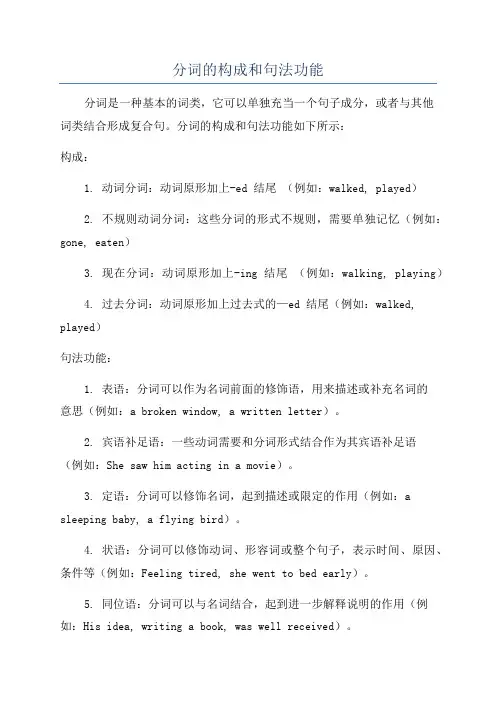
分词的构成和句法功能分词是一种基本的词类,它可以单独充当一个句子成分,或者与其他词类结合形成复合句。
分词的构成和句法功能如下所示:构成:1. 动词分词:动词原形加上-ed 结尾(例如:walked, played)2. 不规则动词分词:这些分词的形式不规则,需要单独记忆(例如:gone, eaten)3. 现在分词:动词原形加上-ing 结尾(例如:walking, playing)4. 过去分词:动词原形加上过去式的—ed 结尾(例如:walked, played)句法功能:1. 表语:分词可以作为名词前面的修饰语,用来描述或补充名词的意思(例如:a broken window, a written letter)。
2. 宾语补足语:一些动词需要和分词形式结合作为其宾语补足语(例如:She saw him acting in a movie)。
3. 定语:分词可以修饰名词,起到描述或限定的作用(例如:a sleeping baby, a flying bird)。
4. 状语:分词可以修饰动词、形容词或整个句子,表示时间、原因、条件等(例如:Feeling tired, she went to bed early)。
5. 同位语:分词可以与名词结合,起到进一步解释说明的作用(例如:His idea, writing a book, was well received)。
6. 独立结构:分词可以独立出现在句子中,不与其他成分相连,表示附加、补充的意思(例如:Having finished his homework, he went out to play)。
需要注意的是,分词的句法功能可以根据具体的上下文和句子结构而有所变化。
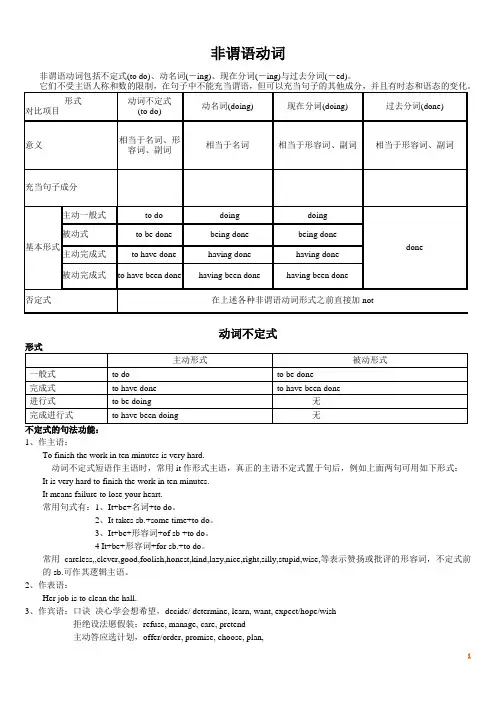
非谓语动词非谓语动词包括不定式(to do)、动名词(-ing)、现在分词(-ing)与过去分词(-ed)。
动词不定式不定式的句法功能:1、作主语:To finish the work in ten minutes is very hard.动词不定式短语作主语时,常用it作形式主语,真正的主语不定式置于句后,例如上面两句可用如下形式:It is very hard to finish the work in ten minutes.It means failure to lose your heart.常用句式有:1、It+be+名词+to do。
2、It takes sb.+some time+to do。
3、It+be+形容词+of sb +to do。
4 It+be+形容词+for sb.+to do。
常用careless,,clever,good,foolish,honest,kind,lazy,nice,right,silly,stupid,wise,等表示赞扬或批评的形容词,不定式前的sb.可作其逻辑主语。
2、作表语:Her job is to clean the hall.3、作宾语:口诀决心学会想希望,decide/ determine, learn, want, expect/hope/wish拒绝设法愿假装;refuse, manage, care, pretend主动答应选计划,offer/order, promise, choose, plan,同意请求帮一帮。
agree, ask/beg, help如果不定式(宾语)后面有宾语补足语,则用it作形式宾语,真正的宾语(不定式)后置,放在宾语补足语后面,例如:Marx found it important to study the situation in Russia.动词不定式也可充当介词宾语,如:I have no choice but to stay here.He did nothing last Sunday but repair his bike.动词不定式前有时可与疑问词连用,如:He gave us some advice on how to learn English.4、作宾语补足语:在复合宾语中,动词不定式可充当宾语补足语,如下动词常跟这种复合宾语:want, wish, ask, tell, order, beg, permit, help, advise, persuade, allow, prepare, cause, force, call on, wait for, invite.此外,介词有时也与这种复合宾语连用,如:With a lot of work to do, he didn't go to the cinema.有些动词如在使役动词make, have, let和感官动词see, watch, notice, observe, feel, hear, listen to, look at等词后接不定式作宾补,不定式不带to,表示做某事的全过程。
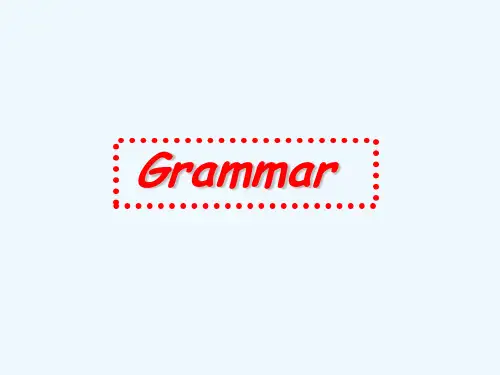
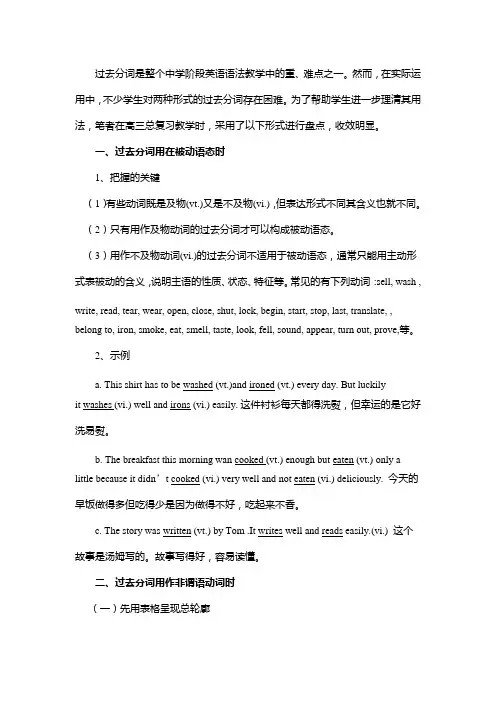
过去分词是整个中学阶段英语语法教学中的重、难点之一。
然而,在实际运用中,不少学生对两种形式的过去分词存在困难。
为了帮助学生进一步理清其用法,笔者在高三总复习教学时,采用了以下形式进行盘点,收效明显。
一、过去分词用在被动语态时1、把握的关键(1)有些动词既是及物(vt.)又是不及物(vi.),但表达形式不同其含义也就不同。
(2)只有用作及物动词的过去分词才可以构成被动语态。
(3)用作不及物动词(vi.)的过去分词不适用于被动语态,通常只能用主动形式表被动的含义,说明主语的性质、状态、特征等。
常见的有下列动词:sell, wash , write, read, tear, wear, open, close, shut, lock, begin, start, stop, last, translate, , belong to, iron, smoke, eat, smell, taste, look, fell, sound, appear, turn out, prove,等。
2、示例a. This shirt has to be washed (vt.)and ironed (vt.) every day. But luckilyit washes (vi.) well and irons (vi.) easily. 这件衬衫每天都得洗熨,但幸运的是它好洗易熨。
b. The breakfast this morning wan cooked (vt.) enough but eaten (vt.) only alittle because it didn’t cooked (vi.) very well and not eaten (vi.) deliciously. 今天的早饭做得多但吃得少是因为做得不好,吃起来不香。
c. The story was written (vt.) by Tom .It writes well and reads easily.(vi.) 这个故事是汤姆写的。


动词过去分词及独立主格结构的用法一、过去分词的定义及其基本形式1.过去分词是动词的另一种非限定形式,过去分词具有动词、形容词和副词的特性,可以带宾语或受状语修饰。
过去分词和宾语或状语一起构成过去分词短语。
如:(1)spoken English 英语口语(过去分词具有形容词的特性,作定语)(2)Given more time, we could do it much better.=If we were given more time, we could do it much better.多给点时间,我们会做得更好些。
(过去分词具有动词的特性,有自己的宾语more time,构成分词短语;过去分词短语在句中作状语,具有副词的特性。
)2.过去分词的基本形式(1)规则动词的过去分词由动词+ed构成(2)不规则动词的过去分词须逐个记忆。
(3)不规则动词的过去分词表示完成,如:fallen leaves =leaves whichhave fallen落叶(4)及物动词的过去分词表示被动或完成,如:the machines used in the workshop=the machines whichare used in the workshop车间用的机器(及物动词的过去分词表示被动)I heard the door opened.=I heard the door has been opened.我听见门被打开了。
(及物动词的过去分词表示被动和完成)二、过去分词的句法功能过去分词是一种非谓语动词,在句中不能单独做谓语。
但它具有形容词和副词的特性,故在句中可以作定语、表语、宾语补足语和状语。
1.作定语作定语用的过去分词如果是单个的词,就放在被修饰的词的前面;若为分词短语则放在所修饰的词的后面。
非谓语动词语法讲解一、非谓语动词的概念动词的基本用法是作谓语。
当句中已经有了谓语动词了,要选或要填的动词就只能用非谓语形式了。
非谓语形式有三种:1、动词不定式:to do 2、动词的ing : doing 3、动词的过去分词:done★不定式:表示目的和将来;动词的ing:表示主动和进行;过去分词:表示被动和完成。
二、非谓语动词的时态和语态完成式进行式·一般式不定式主动to do to have done to be doingto have been done被动@to be doneing 形式主动doing having done被动:having been donebeing done过去分词被动done三.非谓语动词的句法功能:(一)动词不定式:to+do:1.不定式的否定式:not + to do(1)一般式:不定式的一般式所表示的动作与谓语动词动作同时发生I'm glad to meet you.He seems to know a lot.(2)进行式:不定式的动作正在发生The boy pretended to be working hard.He seems to be reading in his room.(3)完成式:不定式的完成式表示的动作发生在谓语动词动作之前I regretted to have told a lie.I happened to have seen the film.(2.不定式的句法功能:(1)作主语:To finish the work in ten minutes is very hard.★动词不定式短语作主语时,常用it作形式主语,真正的主语不定式置于句后It is very hard to finish the work in ten minutes.It means failure to lose your heart.(2)作表语:Her job is to clean the hall.He appears to have caught a cold.(3)作宾语::常与不定式做宾语连用的动词有:want, hope, wish, offer, fail, plan, learn, pretend, refuse, manage, help, agree, promise, prefer。
非谓语中过去分词的用法一、过去分词的定义和形式过去分词是动词的一种非谓语形式,它通常由动词原形加上-ed(或-en)构成。
在句子中作定语、宾语补足语、状语等成分,具有形容词和副词的特点。
二、过去分词作定语1. 描述被修饰名词的特征:例如:a. A broken cup is on the table.桌子上有一个破碎的杯子。
b. The lost cat has been found by its owner.这只丢失的猫被它的主人找到了。
2. 表示被修饰名词所处状态:例如:a. The closed door indicates that the room is occupied.关上的门表明房间已被占领。
b. The fallen leaves covered the ground with a carpet of red and yellow.落叶给地面铺上了一层红黄色的地毯。
3. 说明被修饰名词所属关系:例如:a. The students enrolled in the program are eager to start their study abroad.参加这个项目的学生渴望开始他们的出国学习。
b. The chosen candidate will be informed of the decision next week.被选中的候选人将在下周被通知决定结果。
三、过去分词作宾语补足语过去分词可以用作许多及物动词的宾语补足语,表示主语的状态、感受或经历。
常见的及物动词有:find, see, watch, feel, hear, notice, observe等。
例如:a. I saw a movie directed by Christopher Nolan last night.昨晚我看了一部克里斯托弗·诺兰导演的电影。
b. She felt disappointed when her team lost the game.当她的队输掉比赛时,她感到失望。
现在分词和过去分词的用法一、现在分词(一)现在分词的定义:现在分词(Present Participle)(又称-ing形式、现在进行式) ,是分词的一种,由动词原形+ing形式组成。
具有双重性,一面具有动词的特征,可以有自己的宾语和状语;另一面具有形容词和副词的特征,可以充当表语,定语,状语,补足语,可以表示主动或正在进行的动作,是非谓语动词的一种。
(二)现在分词的功能与用法:1. 作定语单个分词作定语时放在所修饰的名词前,分词短语作定语时放在后,并且名词与现在分词之间存有逻辑上的主谓关系。
一般都可以转化为一个进行时的定语从句。
e.g. a running boy→ a boy who is runningthe girl standing there → a girl who is standing there例如:The report indicated that 45% of students were in jobs not specific qualifications.A. requiringB. to be requiredC. being requiredD. to have required2. 作补语只有两类动词可以加现在分词作宾补:1)感官动词:see hear watch feel notice observe keep find listen to look at2)使役动词:have get catch leave set注意:要想用现在分词来作宾补,只能是用于这些词后,但是并不代表这些动词后的宾补形式都要用现在分词(有些后面可以加不带to的不定式作宾补)。
eg. I saw him singing now.Don’t have the students studying all day.注意:宾语与作宾补的现在分词之间存在逻辑上的主谓关系,即宾语是现在分词动作的发出者。
现在分词和过去分词的用法一、现在分词(一)现在分词的定义:现在分词(Present Participle )(又称-ing 形式、现在进行式) ,是分词的一种,由动词原形+ing 形式组成。
具有双重性,一面具有动词的特征,可以有自己的宾语和状语;另一面具有形容词和副词的特征,可以充当表语,定语,状语,补足语,可以表示主动或正在进行的动作,是非谓语动词的一种。
(二)现在分词的功能与用法:1. 作定语单个分词作定语时放在所修饰的名词前,分词短语作定语时放在后,并且名词与现在分词之间存有逻辑上的主谓关系。
与现在分词之间存有逻辑上的主谓关系。
一般都可以转化为一个进行时的定语从句。
一般都可以转化为一个进行时的定语从句。
e.g. a running boy à a boy w ho is running who is runningthe girl s tanding there standing there à a girl w ho is standing there who is standing there例如:The report indicated that 45% of students were in jobs not specific qualifications. A. requiring B. to be required C. being required D. to have required 2. 作补语只有两类动词可以加现在分词作宾补: 1)感官动词:see hear watch feel notice observe keep find listen to look at 2)使役动词:have get catch leave set注意:要想用现在分词来作宾补,只能是用于这些词后,但是并不代表这些动词后的宾补形式都要用现在分词(有些后面可以加不带to 的不定式作宾补)。
过去分词的变化规则及用法过去分词(past participle)是分词的一种。
规则动词的过去分词一般是由动词加-ed构成(规则见后),不规则动词的过去分词见不规则动词表。
过去分词属于类动词:1. 及物动词的过去分词作表语,与句子的主语是被动关系,表示主语的状态,不但表示被动,还强调已完成了。
The cup is broken. 茶杯破了。
2. 不及物动词的过去分词作表语,与句子的主语是主动关系,表示主语的状态,同样强调动作的完成。
He is retired. 他已退休。
3. 有些过去分词作表语时,构成的谓语很接近被动结构。
构成规则规则变化规则动词的过去分词的构成规则与规则动词的过去式的构成规则相同。
四点变化规则:(1)一般动词,在词尾直接加“-ed ”。
(然而要注意的是,过去分词并不是过去式)work---worked---worked,visit---visited---visited(2)以不发音的“e”结尾的动词,只在词尾加“d ”。
live---lived---lived(3)以“辅音字母+ y ”结尾的动词,将"y" 变为"i" ,再加“-ed”。
study—studied—studied,cry—cried—cried,try—tried—tried,fry—fried—fried.[1](4)重读闭音节结尾,末尾只有一个辅音字母(r、y、x除外),先双写该辅音字母,再加“-ed”。
stop—stopped—stopped,drop—dropped—dropped∙特例:有两类动词本身应该直接加“ed”,但由于历史习惯,依旧要双写最后一个字母,再加“ed”。
以“元音字母+l”非重读结尾的规则动词变过去分词也要双写“l",再加“ed”。
例如cancel→cancelled,dial→dialled。
另外还有一些以非重读闭音节结尾的规则动词变过去分词也要双写最后一个辅音字母,再加“ed”。
过去分词的句法功能
过去分词是一种非谓语动词,在句中不能单独做谓语。
但它具有形容词和副词的特性,故在句中可以作定语、表语、宾语补足语和状语。
(一)定语
作定语用的过去分词如果是单个的词,就放在被修饰的词的前面;若为分词短语则放在所修饰的词的后面。
如:
The excited children are opening their Christmas presents.
兴奋的孩子们正在打开他们的圣诞礼物。
Some of the people invited (=who have been invi ted) to the party can’t come.
有些被邀请参加晚会的人不能来。
注意:(1)做定语用的过去分词通常指已完成的动作,若要表示现在进行的动作则要用过去分词的进行形式。
We must keep a secret of the things being discussed here.
=We must keep a secret of the things which are being discussed here.
我们必须对这里讨论的问题保密。
(2)如指未来的情况,都用不定式的被动形式。
He prepared some poems to be recited at the English evening.
他准备了几首将在英语晚会上朗诵的诗。
例1.The computer centre, ______ last year, is very popular among the students in this school.
A.open B.opening
C.having opened D.opened
答案与简析:选D。
过去分词短语作后置定语,相当于非限制性定语从句which was opened.
过去分词作后置定语课文中的例句:
And this landscape is also wonderfully compact, so you can stride over grassy slopes with spectacular views of idyllic lakes far below, set against imposing peaks.
(二)表语
Be prepared! 做好准备!
Everybody got excited about the boat trip.
大家对坐船游览倍感兴奋。
(三)宾(主)语补足语
What made you so frightened?
什么使你这样惊恐?
He was found injured at the foot of a cliff.
他被发现在山岩脚下受了伤。
例2.The managers discussed the plan that they would like to see ______ the next year.
A.carry out B.carrying out
C.carried out D.to carry out
答案与简析:选C。
过去分词短语在定语从句中作宾补。
(四)做状语
1.Born into a peasant family (=As he was born into a peasant family), he had only two years of schooling.(由于)他出生于农民家庭,他只上了两年学。
2.United we stand, divided we fall.
=(If we are) United we stand and (=If we are divided) we fall.
团结则存,分裂则亡。
3.We went home exhausted (=and were exhausted).
我们筋疲力尽地回到了家里。
4.Tucked away (=Although it is tucked away) in one corner of northwest England, the Lake District is quite unique.
5. Now preserved(=Since/As it is now preserved 该结构置于句首作为原因状语更贴切,若置于句尾则可视为伴随状语)forever as the Lake District National Park, this lovely corner of the country is quintessentially English.
6.分词有时和连词一起用,相当于状语从句的省略。
Robbie had arranged for this man to come whenever (he was) needed.
罗比已安排好,随时需要这人就可以来。
例3.The child complained that the old man made no answer when _____ where he lived.
A.asking B.asked
C.to ask D.having asked
答案与简析:选B。
状语从句的省略when (he was) asked.
注意:当修饰人的表情、眼神、眼泪、声音时要用-ed形式。
例.Her frightened face showed us what had happened to her family.。